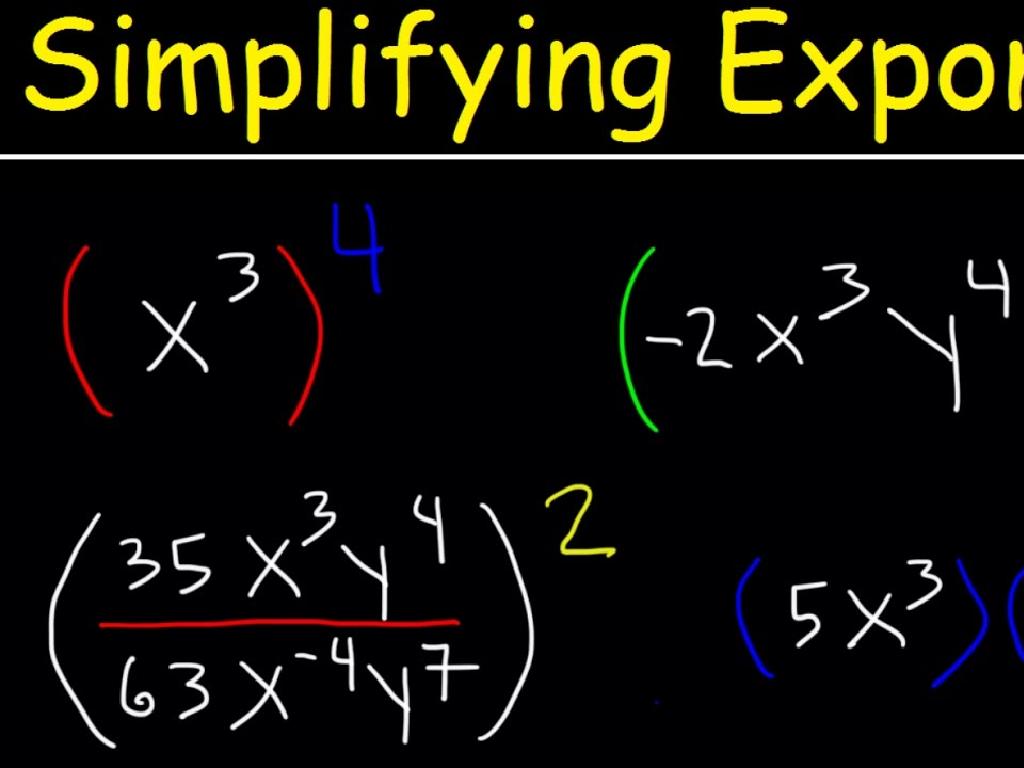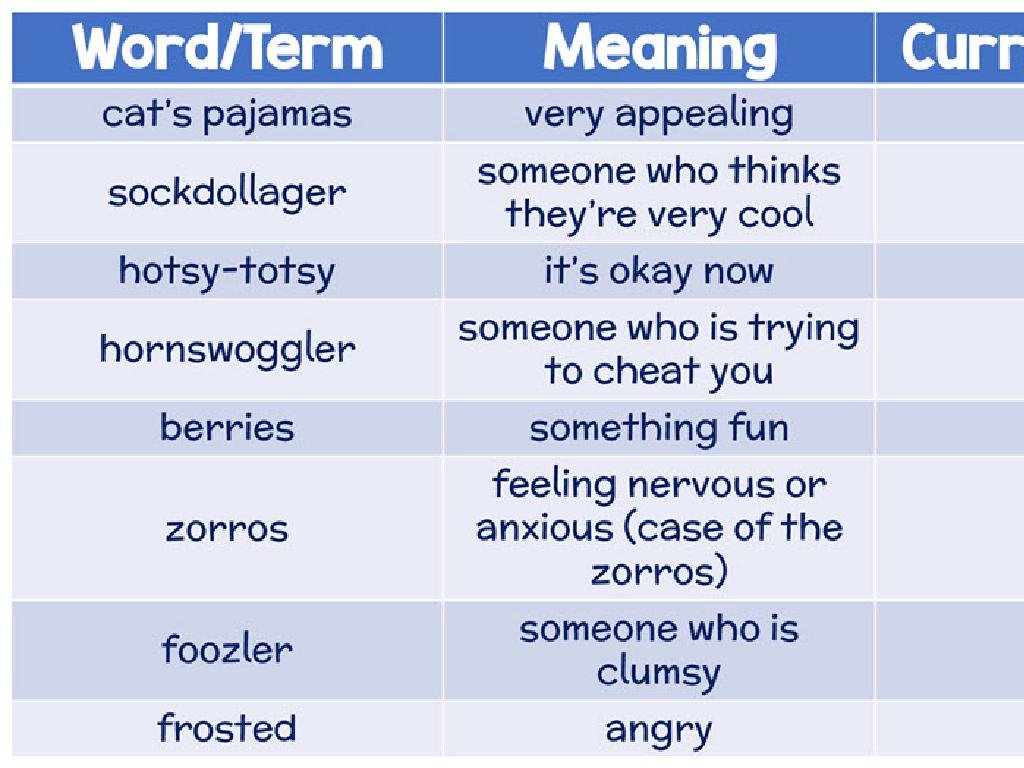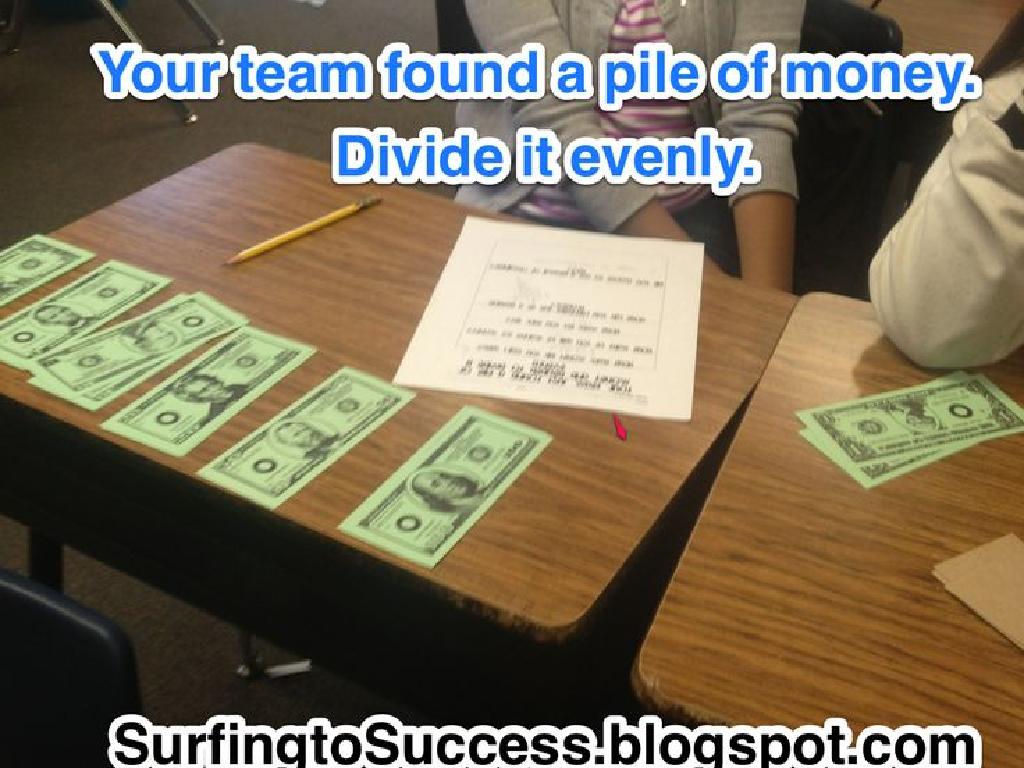Identify Action Verbs
Subject: Language arts
Grade: Fourth grade
Topic: Verb Types
Please LOG IN to download the presentation. Access is available to registered users only.
View More Content
Today’s Adventure: Identifying Action Verbs!
– Explore different verb types
– Focus on action verbs
– Verbs that show what someone or something does, e.g., ‘run’, ‘jump’, ‘think’
– Understand why action verbs are key
– They make sentences exciting and give us information on what is happening
– Engage in fun verb activities
|
This slide introduces the concept of verb types with a focus on action verbs, which are crucial for constructing clear and dynamic sentences. Action verbs are the words that express physical or mental actions, and they are essential for bringing life to our language. Explain that without action verbs, our sentences would be static and lack the movement necessary to convey what’s happening. Engage the students with examples and encourage them to think of action verbs they use every day. Plan interactive activities where students can act out action verbs or find them in their favorite stories, enhancing their understanding and retention of the concept.
Understanding Verbs: Action Words!
– Verbs show action or state
– Examples: ‘run’, ‘jump’, ‘is’, ‘are’
– ‘Run’ and ‘jump’ show action; ‘is’ and ‘are’ show a state of being
– Verbs are central in sentences
– Identifying action verbs
– Action verbs are words that show what someone or something is doing
|
This slide introduces the concept of verbs to fourth-grade students, emphasizing their importance in sentences as action or state-indicating words. Start by explaining that verbs are like the heartbeat of a sentence – they bring the subject to life by showing what it is doing or how it is being. Provide clear examples of action verbs like ‘run’ and ‘jump’ and state of being verbs like ‘is’ and ‘are’. Engage the class by asking them to find verbs in sentences and determine if they show action or a state of being. This will help them understand how verbs function within the context of a sentence and prepare them for identifying action verbs specifically.
Meet the Action Verbs
– Action verbs show actions
– Like ‘run’, ‘jump’, ‘eat’
– Can be physical or mental
– Like ‘believe’, ‘guess’, ‘know’
– Examples: swim, think
– Examples: dance, wonder
|
This slide introduces the concept of action verbs to the students. Action verbs are words that show what the subject of the sentence is doing. They can represent both physical actions, like ‘run’ or ‘jump’, and mental actions, such as ‘think’ or ‘believe’. Provide students with clear examples to illustrate the difference between physical and mental actions. Encourage them to come up with their own examples of action verbs and use them in sentences. This will help them understand how action verbs are used in everyday language and improve their ability to identify them in various texts.
Spot the Action: Identifying Action Verbs
– Understanding action verbs
– Action verbs tell us what action is happening
– Finding the ‘doing’ word
– It’s the word that shows action in a sentence
– Example: ‘The dog runs’
– ‘Runs’ shows what the dog is doing
– Practice with sentences
|
This slide is aimed at helping fourth-grade students recognize and understand action verbs within sentences. Begin by explaining that action verbs are words that show what someone or something is doing. Encourage students to look for the verb in a sentence by finding the action or what is happening. Use the example provided to illustrate how ‘runs’ is the action verb that tells us what the dog is doing. After explaining, engage the students with practice sentences where they can identify the action verbs themselves. This interactive approach helps solidify their understanding of action verbs in a fun and engaging way.
Action Verb Hunt Activity
– Find action verbs in a book
– Look for words that show what someone or something is doing.
– Share verbs with the class
– Tell us the action verbs you found and where they are in the story.
– Discuss verbs’ role in the story
– Why do you think these action verbs are important? How do they help the story?
|
This activity is designed to help students identify and understand the use of action verbs in literature. By searching for action verbs in a book they enjoy, students will learn how these verbs contribute to the vivid storytelling and engage the reader. Encourage students to pick out verbs that clearly show the actions of characters or objects. During the sharing session, prompt them to explain the context of each verb and its importance to the narrative. This will enhance their comprehension of how action verbs drive the action and support the plot. Prepare to facilitate a discussion on the significance of action verbs in storytelling, highlighting their role in bringing stories to life.
Action Verbs in Our Lives
– Reflect on your daily routine
– Find action verbs you often use
– Verbs like ‘eat’, ‘play’, ‘run’, ‘read’
– Discuss with a classmate
– Take turns sharing your verbs
– Compare your lists of verbs
– See which verbs are common and which are unique
|
This slide is designed to engage students in a practical exercise to identify action verbs through personal reflection and peer interaction. Start by asking students to think about the activities they do every day. Encourage them to list verbs that describe these actions. Then, have them pair up with a classmate to discuss their findings. This will help them understand how frequently they use action verbs in daily communication. Finally, encourage them to compare their lists and notice the verbs that are common between them and the ones that are unique to their own lists. This activity will help solidify their understanding of action verbs and how they are used in everyday language.
Create Your Action Sentences
– Write sentences with action verbs
– Ensure verbs show clear action
– Verbs like ‘run’, ‘jump’, ‘write’ show action
– Use strong action verbs
– Words like ‘sprint’ are more vivid than ‘go’
– Example: ‘I sprint to the bus stop’
|
This slide is designed to engage students in an activity where they create their own sentences using action verbs. Action verbs are words that show what someone or something is doing. Encourage the students to choose verbs that are strong and clear, making the action in their sentences vivid and easy to picture. For example, ‘sprint’ is a more powerful word than ‘go’ because it gives a clearer image of the action. Have the students think of actions they do every day to help them come up with their sentences. This activity will help them understand how to make their writing more dynamic and engaging.
Class Activity: Verb Charades
– Let’s play Verb Charades!
– Act out an action verb silently
– Mimic an action like ‘jump’ or ‘write’ without using words
– Classmates guess the verb
– Observe and shout out the verb you think is being acted out
– Have fun and learn together
|
This interactive activity is designed to help students identify action verbs through a game of charades. Each student will take turns acting out an action verb without speaking, while their classmates try to guess the verb based on the actions performed. This will not only reinforce the concept of action verbs but also encourage active participation and engagement. For the teacher: Prepare a list of action verbs suitable for the activity, ensure every student gets a turn, and facilitate the game to maintain a fun and educational environment. Possible verbs to act out could include ‘run’, ‘eat’, ‘climb’, ‘paint’, etc. Remember to praise correct guesses and provide gentle guidance when needed.
Conclusion & Action Verbs Homework
– Congrats on learning action verbs!
– Write a short story for homework
– Let your imagination run wild and create an exciting tale
– Include ten different action verbs
– Action verbs are words like ‘run’, ‘jump’, and ‘think’
– Share your stories in the next class
– We’ll discuss and enjoy everyone’s action-filled adventures!
|
Well done on today’s lesson about action verbs! As a homework assignment, students are expected to write a short story that incorporates at least ten different action verbs. This will help reinforce their understanding of action verbs and encourage them to apply what they’ve learned in a creative context. Remind them that action verbs are words that show what someone or something is doing. Encourage creativity and the use of a variety of verbs to make their stories engaging. In the next class, we will have a sharing session where each student will have the opportunity to present their story, allowing them to practice their speaking skills and celebrate their writing efforts.






